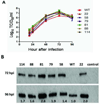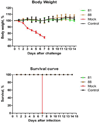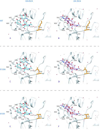Error-prone pcr-based mutagenesis strategy for rapidly generating high-yield influenza vaccine candidates
- PMID: 25899178
- PMCID: PMC4461506
- DOI: 10.1016/j.virol.2015.03.051
Error-prone pcr-based mutagenesis strategy for rapidly generating high-yield influenza vaccine candidates
Abstract
Vaccination is the primary strategy for the prevention and control of influenza outbreaks. However, the manufacture of influenza vaccine requires a high-yield seed strain, and the conventional methods for generating such strains are time consuming. In this study, we developed a novel method to rapidly generate high-yield candidate vaccine strains by integrating error-prone PCR, site-directed mutagenesis strategies, and reverse genetics. We used this method to generate seed strains for the influenza A(H1N1)pdm09 virus and produced six high-yield candidate strains. We used a mouse model to assess the efficacy of two of the six candidate strains as a vaccine seed virus: both strains provided complete protection in mice against lethal challenge, thus validating our method. Results confirmed that the efficacy of these candidate vaccine seed strains was not affected by the yield-optimization procedure.
Keywords: Error-prone PCR; High-yield strain; Influenza A virus; Vaccine; Vaccine production.
Copyright © 2015 Elsevier Inc. All rights reserved.
Figures







References
Publication types
MeSH terms
Substances
Associated data
- Actions
- Actions
- Actions
Grants and funding
LinkOut - more resources
Full Text Sources
Other Literature Sources
Medical

